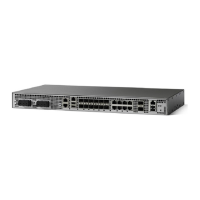are used to tune the TDM clock frequency from the sending end to the receiving end. Both ends have a source
traceable reference. Because of this, the recovered clock is not affected by PDV when using DCR.
In contrast with DCR, a PRC traceable clock source is available at each end. ACR is used when a traceable
source is not available at both ends of the PSN link.
The recreated service clock accuracy is dependent on the accuracy between the sending and receiving PRC
frequencies.
Benefits of Clock Recovery
•
Customer-edge devices (CEs) can have different clock from that of the Provide-edge devices (PEs).
•
In CESoPSN, a slave clock is supported for clock redundancy.
Scaling Information
Pseudowires Supported (Number of Clocks Derived)IM Card
4848-Port T1/E1 CEM Interface Module
Prerequisites for Clock Recovery
•
The clock of interface modules must be used as service clock.
•
CEM must be configured before configuring the global clock recovery.
•
RTP must be enabled for DCR in CEM, as the differential clock information is transferred in the RTP
header.
Restrictions for Clock Recovery
•
The reference clock source is used and locked to a single clock.
1-Port OC-192 or 8-Port Low Rate CEM Interface Module Configuration Guide, Cisco IOS XE Everest 16.7.x (Cisco
ASR 900 Series)
57
Configuring SONET
Benefits of Clock Recovery

